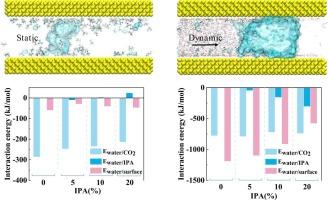超临界二氧化碳在硅片纳米孔中去除水的微观结构和扩散行为:实验和分子动力学模拟
IF 4.4
3区 工程技术
Q2 CHEMISTRY, PHYSICAL
引用次数: 0
摘要
在半导体器件的制造中,尤其是晶圆加工中,干燥过程是一个关键的加工步骤。晶圆制造中关键尺寸的不断减小使得传统湿法加工技术引起的结构崩溃(变形或弯曲)成为一个日益严重的问题。超临界二氧化碳(scCO₂)由于其不存在表面张力,具有作为硅片纳米结构的有效置换剂和干燥介质的巨大潜力。然而,对硅片纳米结构中残留水的干燥机制的了解仍然不足。本文采用平衡和非平衡分子动力学模拟方法,详细研究了不同浓度异丙醇(IPA)共溶剂对scCO2介质中硅片硅纳米孔残水去除的微观结构和扩散行为。IPA用量的增加有利于水滴在scCO2中的分散,水溶解能垒降低。在scCO2流体驱油过程中,残余水分子发生整体驱替和膨胀行为。实验结果表明,随着IPA处理时间的延长和添加量的增加,纳米晶片结构中的残余盐浓度小于10 μm,甚至低于电感耦合等离子体发射光谱(ICP-OES)的检测限,这证实了超临界干燥纳米晶片的有效性。此外,干燥效率表现出明显的特征尺寸依赖性。总的来说,这些发现对于在scCO2干燥过程中为硅片微/纳米结构中的水去除过程提供基本的分子水平的见解至关重要。本文章由计算机程序翻译,如有差异,请以英文原文为准。

Understanding into the microstructure and diffusion behaviors of water removal in nanopores of wafer by supercritical carbon dioxide: Experiment and molecular dynamics simulation
In the fabrication of semiconductor devices, especially wafer processing, drying process constitutes a critical processing step. The continuing reduction of critical dimensions in wafer manufacturing has rendered structural collapse (deformation or bending) induced by conventional wet processing techniques an increasingly severe issue. Supercritical carbon dioxide (scCO₂), owing to its absence of surface tension, demonstrates significant potential as an effective displacement agent and drying medium for nanostructure of wafer. However, the understanding of the underlying drying mechanisms for the residual water in the nanostructure of wafer remains insufficient. Herein, the microstructure and diffusion behaviors of residual water removal in silicon nanopores of wafers in the scCO2 medium affected by various concentrations of isopropanol (IPA) co-solvent using equilibrium- and non-equilibrium molecular dynamics simulations were studied in details. The increased amount of IPA contributes to the better dispersion of water droplet in the scCO2 with lower energy barrier of water dissolution. The residual water molecules undergo overall displacement and swelling behaviors during the scCO2 fluid flooding process. The experimental results indicate that with the increasing treatment time and additive amount of IPA, the residual salt concentrations in the microscale structures less than 10 μm, even below the detection limit of Inductively-Coupled Plasma Optical Emission Spectrometry (ICP-OES), which confirms the effectiveness of supercritical drying of wafer nanopatterns. Furthermore, the drying efficiency shows distinct feature-size dependence. Overall, these findings are of paramount importance to provide fundamental molecular-level insights into water removal processes in micro/nano structures of wafer during drying by scCO2.
求助全文
通过发布文献求助,成功后即可免费获取论文全文。
去求助
来源期刊

Journal of Supercritical Fluids
工程技术-工程:化工
CiteScore
7.60
自引率
10.30%
发文量
236
审稿时长
56 days
期刊介绍:
The Journal of Supercritical Fluids is an international journal devoted to the fundamental and applied aspects of supercritical fluids and processes. Its aim is to provide a focused platform for academic and industrial researchers to report their findings and to have ready access to the advances in this rapidly growing field. Its coverage is multidisciplinary and includes both basic and applied topics.
Thermodynamics and phase equilibria, reaction kinetics and rate processes, thermal and transport properties, and all topics related to processing such as separations (extraction, fractionation, purification, chromatography) nucleation and impregnation are within the scope. Accounts of specific engineering applications such as those encountered in food, fuel, natural products, minerals, pharmaceuticals and polymer industries are included. Topics related to high pressure equipment design, analytical techniques, sensors, and process control methodologies are also within the scope of the journal.
 求助内容:
求助内容: 应助结果提醒方式:
应助结果提醒方式:


